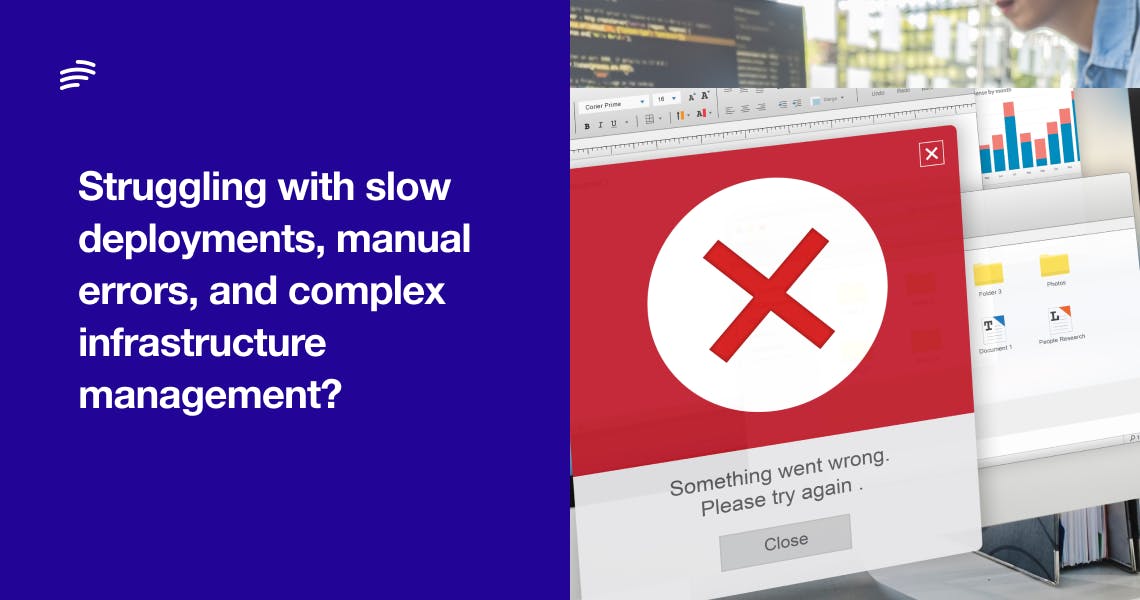Engineering teams face numerous challenges as they navigate the complexities of modern infrastructure and deployment. From managing multiple environments to reducing feedback loops and mitigating manual errors, engineering leaders are under constant pressure to improve operational efficiency and accelerate product delivery. This article explores these pain points in detail, highlighting how Bunnyshell can be a transformative ally in overcoming these challenges and fostering a resilient, automated, and scalable environment for teams.
| Heading | Subtopics |
|---|---|
| Introduction | Importance of efficient engineering processes and infrastructure management |
| 1. Keeping Pace with Infrastructure Changes | - Issues with rapid infrastructure evolution - Effects on productivity and team adaptability |
| 2. Inefficiencies in Deployment and Manual Processes | - Manual deployment challenges - Delays impacting release cycles and business KPIs |
| 3. Customer Satisfaction and Revenue at Risk | - Delayed releases affect customer experience - Consequences on business growth and competitive positioning |
| 4. Manual Workflows and Increased Risk of Human Error | - Potential for error and rework - Impact on product quality and release speed |
| 5. Migrating Legacy to Modern Infrastructure | - Obstacles in transitioning to new systems - Balancing server management and high availability |
| 6. Merge Conflicts and Cross-Team Collaboration | - Code conflicts and engineering time loss - Managing dependencies between multiple teams |
| 7. Development Bottlenecks Due to Manual Processes | - Configuration drift and versioning issues - Bottlenecks affecting development velocity |
| 8. Complexity of Managing Multiple Development Environments | - Syncing Dev, Pre-Dev, UAT, and Production - Challenges in environment maintenance and updates |
| 9. Prolonged Feedback Loops Between Developers and QA | - How delays slow down release cycles - The importance of faster QA processes |
| 10. Slow Testing Cycles for Complex Applications | - Impacts of lengthy test cases - Solutions to reduce testing times significantly |
| 11. Configuration and Deployment Management | - Ensuring consistent configurations - Effects on the deployment process and infrastructure changes |
| 12. Onboarding New Developers with Legacy and New Systems | - Difficulties in getting new team members up to speed - Streamlining onboarding with automated processes |
| 13. Challenges in Environment Management | - Complexities in managing environment states - Dependencies on manual intervention and the risks involved |
| 14. Local Development Bottlenecks | - Productivity impacts of local machine dependency - Addressing slow performance in local development environments |
| 15. Merging Legacy and Modern Infrastructure | - Handling integration of older codebases with new infrastructure - Streamlining the merge process between systems |
| 16. Configuration Drift Between Environments | - How to reduce inconsistencies across environments - Tools to help maintain sync across development, staging, and production |
| 17. Test Automation and QA Resource Constraints | - Limitations of manual QA testing - Using automation to reduce testing time and improve efficiency |
| 18. Isolated Environments for Effective Testing | - Benefits of isolated testing environments - Avoiding conflicts in shared environments |
| 19. Scaling DevOps Resources for Optimal Productivity | - Challenges faced by small DevOps teams - Solutions to improve resource management and efficiency |
| 20. Addressing Staging vs. Production Performance Issues | - Differences in environment-specific performance - Techniques to better manage and monitor performance between environments |
| 21. Automating Environment Management for Consistency | - How automation boosts efficiency and consistency - Bunnyshell’s role in automated environment management |
| 22. Streamlining the Merge Process and Reducing Conflicts | - Benefits of automated merge conflict resolution - How sandboxed environments improve team collaboration |
| 23. Improving Feedback Loops with Automated Testing | - How automated testing can reduce delays - Importance of faster testing solutions for large-scale applications |
| 24. Managing Diverse Testing Requirements | - Testing for different environments and configurations - Solutions for faster and more reliable testing |
| Conclusion | - How Bunnyshell addresses critical pain points - Benefits of adopting a modern, automated approach to engineering management |
Introduction
Engineering teams today face a host of challenges as they work to build and maintain reliable, scalable, and high-performing systems. From navigating infrastructure changes to balancing the needs of multiple environments, teams are constantly finding new ways to optimize processes and accelerate release cycles. Unfortunately, inefficiencies, manual workflows, and infrastructure constraints can slow progress, impact product quality, and even affect customer satisfaction.
Bunnyshell offers a range of solutions designed to streamline operations, reduce manual tasks, and foster a more agile development environment. By addressing critical pain points in the engineering process, Bunnyshell enables teams to focus on innovation rather than routine maintenance and deployment tasks. This article outlines the most pressing challenges faced by engineering leaders and explores how Bunnyshell can help teams overcome these obstacles.
1. Keeping Pace with Infrastructure Changes
In the ever-evolving tech landscape, infrastructure changes occur frequently, often outpacing an organization’s ability to keep up. Teams are responsible for ensuring that systems are up-to-date, secure, and operational while maintaining a fast-paced development cycle. Engineering leaders recognize the importance of keeping infrastructure aligned with current industry standards, but without automated tools, they often struggle to stay ahead.
Bunnyshell helps teams adapt to these changes more efficiently by automating infrastructure management. This allows teams to focus more on feature development and less on infrastructure maintenance. Through Bunnyshell’s automated processes, organizations can quickly and easily update their infrastructure, minimizing downtime and boosting productivity.
2. Inefficiencies in Deployment and Manual Processes
Deployment cycles that rely heavily on manual processes can lead to significant delays. Teams may face hours-long deployments involving manual checks, troubleshooting, and coordination. Each manual step introduces potential for error, causing delays in application release cycles and impacting key performance metrics.
Bunnyshell addresses these challenges by automating the deployment pipeline, which allows for quicker, more reliable releases. Through automation, teams can reduce their reliance on manual processes, speeding up deployment and minimizing the risk of human error. The result is an increase in both deployment speed and quality, ultimately benefiting the organization’s bottom line.
3. Customer Satisfaction and Revenue at Risk
Customers today expect fast, reliable, and consistent updates from the products they use. Engineering delays directly impact customer satisfaction, potentially affecting the company's reputation and revenue. Slow response times and inconsistent product quality can frustrate users and drive them toward competitors with more streamlined development and release cycles.
With Bunnyshell, teams can expedite the deployment process and ensure faster delivery of new features and improvements. This means a shorter time-to-market for product updates, allowing businesses to meet customer expectations and maintain a competitive edge.

Unlock the Secrets of Leading Tech Innovators in Software Development
Learn how Netflix, Etsy, Shopify, GitLab, and Airbnb—have revolutionized their development processes by implementing preview environments and ephemeral test environments
4. Manual Workflows and Increased Risk of Human Error
In engineering processes, repetitive manual tasks can quickly lead to errors, resulting in costly rework, refactoring, and delays. Manual workflows not only slow down the release process but also increase the potential for bugs and inconsistencies in the product. Engineering teams need to minimize human error to maximize the reliability and performance of their systems.
Automation is crucial in reducing manual labor and ensuring consistent workflows. Bunnyshell automates routine tasks, reducing the likelihood of error and allowing teams to focus on more strategic work. By removing manual processes from critical workflows, Bunnyshell helps improve accuracy and consistency across engineering tasks.
5. Migrating Legacy to Modern Infrastructure
Transitioning from legacy systems to modern infrastructure is challenging, particularly for teams that need to balance ongoing development with maintaining uptime. Migrating systems without impacting performance requires careful planning and coordination, and manual processes can slow down this process significantly.
Bunnyshell provides tools to support seamless migration efforts. With automated provisioning and management capabilities, Bunnyshell makes it easier for teams to build, test, and deploy new environments, allowing for smoother transitions and minimizing the potential for downtime during migration.
6. Merge Conflicts and Cross-Team Collaboration
When multiple teams work on different features within the same codebase, merge conflicts are inevitable. These conflicts not only waste valuable engineering time but can also disrupt development flow and slow down release cycles. Managing dependencies and resolving conflicts manually adds further strain to engineering resources.
Bunnyshell offers sandboxed environments and automated merge conflict resolution tools, enabling teams to work on separate branches without interfering with one another. By minimizing conflicts and providing tools for automated resolution, Bunnyshell streamlines collaboration and reduces time spent on non-productive tasks.
Ready to accelerate your product delivery?
Discover how Bunnyshell can automate your development environments, boost your team's productivity, and reduce infrastructure costs. Let us show you the power of ephemeral environments tailored to your company’s needs.
7. Development Bottlenecks Due to Manual Processes
Bottlenecks can significantly impact development speed, especially when manual processes are involved. For instance, configuration drift between development environments can lead to integration issues and version inconsistencies. Without an efficient system to manage these variations, teams often encounter delays when syncing local and remote environments.
Bunnyshell automates configuration management, reducing the risk of bottlenecks and ensuring that environments remain consistent. With automated version control and synchronization, teams can work faster and more effectively, reducing downtime and improving the overall development experience.
8. Complexity of Managing Multiple Development Environments
Managing multiple environments, from development to staging and production, requires constant attention and resources. Many teams struggle to keep environments in sync, which can lead to problems when updates or changes are needed. Ensuring consistency across environments is key to maintaining smooth operations and minimizing downtime.
Bunnyshell simplifies environment management by enabling teams to easily create, update, and maintain multiple environments without extensive manual effort. By automating these tasks, Bunnyshell ensures that all environments remain aligned, reducing the risk of inconsistencies and downtime.
9. Prolonged Feedback Loops Between Developers and QA
Feedback delays between development and QA teams can slow down the release process. Longer feedback loops can cause issues to go unaddressed, leading to bugs and quality issues in the final product. To ensure a more efficient release cycle, engineering teams need faster QA processes and shorter feedback loops.
Bunnyshell enables automated testing and continuous integration, providing faster feedback and reducing the time developers spend waiting for QA validation. This results in quicker issue resolution and an overall improvement in product quality.
10. Slow Testing Cycles for Complex Applications
Testing is an essential part of the development process, but for complex applications, test cycles can be lengthy and resource-intensive. Testing that takes 20–30 minutes or more can significantly slow down the release process, making it difficult for teams to respond quickly to new requirements or changes.
Bunnyshell provides automation tools that streamline testing, allowing for faster test cycles and quicker validation of new code. By reducing testing times, Bunnyshell enables engineering teams to accelerate their release cycles and respond to changes more effectively.
Conclusion
Engineering teams face numerous challenges that can hinder productivity, impact customer satisfaction, and affect the bottom line. Manual workflows, lengthy deployment cycles, and complex environment management requirements make it difficult for teams to keep up with today’s fast-paced development landscape. However, with Bunnyshell, teams can automate and streamline many of these tasks, allowing them to focus on innovation rather than routine maintenance.
By addressing these pain points with an automated, scalable, and reliable solution, Bunnyshell enables engineering teams to operate more efficiently, respond to change more rapidly, and deliver high-quality products that meet customer expectations. As technology continues to evolve, Bunnyshell’s platform will provide engineering teams with the tools they need to stay competitive, improve customer satisfaction, and drive business success.
Ship 10x Faster
Boost productivity with automated environments for each pull request, giving developers instant access to test, review, and deploy code more efficiently.
